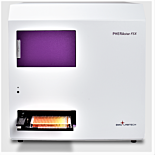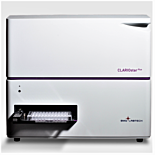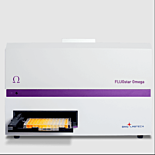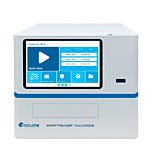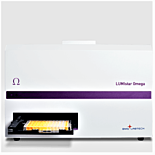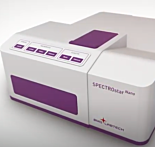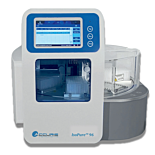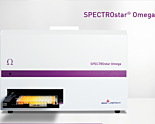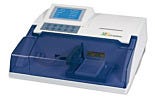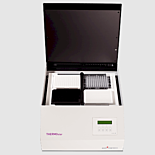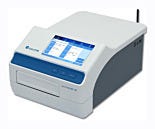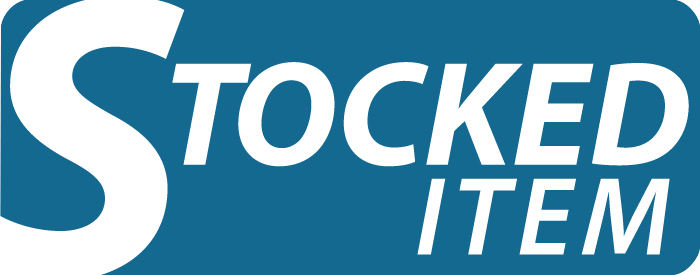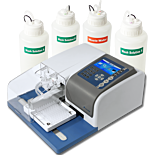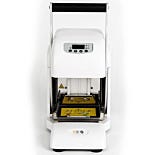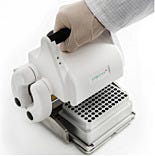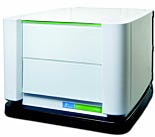

What is a Microplate?
Microplates, or microtiter plates, are designed to hold microliter aliquots of samples for analytical research and clinical diagnostic testing.
Microplate Sample Size
While standard microplates contain 96 or 384 sample wells, specialized plates can hold up to 3,456 samples for high-throughput screening. Along with test tubes and microtubes, microplates are a commonly-used vessel for sample processing, preparation, testing and analysis. Although many lab instruments, such as incubators, shakers, mixers, and centrifuges include adapters to accept microplates, three instruments are designed specifically for microplate-based assays: plate readers, plate washers and plate sealers.
A - Microplate Format
(back to chart)
A1 - Microplate Reader Uses and Applications
Microplate readers detect optical signals stemming from biochemical reactions, property changes, or the presence of analytes within each sample stored by the microplate. Commonly used in the life science, pharmaceutical, academic research, food and cosmetic industries, microplate readers are designed to analyze up to 3,456 samples during a single run, helping high throughput labs minimize operational time and save on reagent costs.
How Does a Microplate Reader Work?
Microplate readers utilize a broadband Xenon lamp to shine a light through the sample to excite the analyte. Once excited, the analyte emits light at a specified wavelength, which is filtered through a monochromator and detected by a photomultiplier tube, or PMT. The light detected by the PMT is quantified by the microplate reader’s software for further analysis. As each biochemical reaction yields a different optical change, microplate readers are compatible with different detection filters, monochromators, and detection modes to support the analysis of different sample types. The three most common detection modes are absorbance, fluorescence intensity, and luminescence.
Common applications for microplate readers include nucleic acid quantitation, protein purification, ELISA immunoassay analysis, and cell viability studies. But, microplate readers are also used for high-throughput screening of drug targets, protein-protein interaction studies, enzyme activity analysis, and cell toxicity and proliferation examinations.
A2 - Microplate Washers for Cell Culture, Assays, and Blots
Microplate washers tightly control and automate the process of washing samples housed within microtiter plates, as most microplate-based assays require a series of washes, m. Microplate washers contain a plate deck, a robotic manifold to control fluid dispensing, a series of microfluidic tubes connecting the manifold to bottles of solution (such as wash solution, buffer and DI water) and a digital controller to operate the system. Used commonly to wash cell cultures, western blots, ELISA assays, and protein arrays, microplate washers accommodate several microplate sizes (6-well, 30-well, 96-well, 384-well) and styles (deep-well, flat-bottom, semi-skirted and full-skirted). The digital controller saves user-written programs defining dispensing volume, aspiration volume, and wash cycle quantity. As opposed to mechanical plate washing, automated washers offer increased aspiration and dispensing precision, limited risk of sample cross-contamination, and shorter cycle times.
A3 - Microplate Heat Sealers for PCR Assays & ELISA Assays
Microplate heat sealers automatically place a plastic or foil seal over the microplate to protect samples from cross-contamination and evaporation. Microplate heat sealers include a plate deck, seal dispenser, heating element, ergonomic lever (for mechanical models), and digital controller. Heat sealers include optional plate adapters to accommodate different microplate sizes (6-well, 30-well, 96-well, 384-well) and styles (deep-well, flat-bottom, semi-skirted and full-skirted). Used commonly for sample storage, sample archiving, PCR assays, ELISA assays, and high-throughput screening (HTS), microplate sealers ensure a more uniform, air-tight, longer-lasting seal than mechanical methods.
B - Detection Mode
(back to chart)
B1 - Microplate Absorbance Reader
Absorbance detection measures the amount of light absorbed by the molecules within a given sample by comparing the amount of light produced by the excitation source to the amount of light measured by the detector. Molecules absorb light at known, specified wavelengths within the visible and non-visible spectrum. For example, DNA and protein molecules absorb UV light (at 254 nm), chlorophyll molecules absorb blue and red light, and hemoglobin molecules absorb red and green light. Measuring the amount of light, at a given wavelength, that is lost while transmitted through the sample allows the researcher to quantify the molecules within the sample.
What Are Absorbance Measurements Used For?
Absorbance measurements are used in applications such as microbial growth, cell viability, nucleic acid quantitation, and ELISA assays.
B2 - Microplate Fluorescence Reader
Fluorescence intensity, including FRET, detection combines the principles of light absorption and emission with a targeted assay using fluorescently-labeled molecules. Light, commonly from a Xenon lamp source, is shone into the sample to excite targeted molecules labeled with fluorescent dyes or probes. The targeted molecules absorb the light and, nearly instantaneously, alter the chemical construction of the probe or dye to release fluorescent light at a specified wavelength. The fluorescent light is filtered through a monochromator and detected using a photomultiplier tube. As the light intensity is correlative to the concentration of the fluorophore, fluorescence detection is used to quantify the molecules within a given sample.
What is Fluorescence Detection Used For?
Fluorescence detection is commonly used for enzyme activity and aggregation assays, reactive oxygen species studies, and DNA quantitation.
B3 - Microplate Luminescence Reader
Unlike absorbance and fluorescence detection modes, luminescence does not utilize a light source to excite the molecules within a given sample. The light generated by the sample, and detected by the microplate reader, is the result of a spontaneous chemical reaction or enzyme catalysis.
What is Luminescence Detection?
Luminescence detection is commonly used for receptor-ligand binding studies, reporter assays and cell viability experiments.
C - Digital vs Analog Microplate Controllers
(back to chart)
C1 - Analog Microplate Controller
ITL Virginia’s MicroTS microplate heat sealer includes an analog controller with an LED light to indicate when the unit has reached optimal sealing temperature.
C2 - Digital Microplate Controller
Each of BMG Labtech’s microplate readers include digital controllers with on-board software to chart and export assay measurements. The reader control and data analysis software is compliant with 21 CFR Part 11 requirements for highly-regulated labs.
D - Microplate Voltage
(back to chart)
120-volt connections are suitable for standard laboratory power outlets in the United States, Canada, Mexico, and South America.
240-volt connections, common in Mainland Europe and throughout Asia, require less current (amperage) and smaller conductors than equipment designed to operate at 120-volt.
E - Microplate Wash Volumes
(back to chart)
The SmartWasher 96 by Accuris Instruments accommodates washing protocols specifying wash volumes between 50 ul and 2 ml. Liquid level sensors in the wash and waste bottles inform the user of low wash supply and overfilled waste.
The ACTGene AgileWasher accommodates wash volumes of 50 ul to 3 ml and yields a residual volume of <1 ul per well.
F - Microplate Plate Format and Sample Capacity
(back to chart)
96 Well Microplates and Standard Sizes for ELISA Assays
Although 6-well, 30-well and 48-well microplates are used for ELISA assays and special applications, the most common microplate capacities are 96-well, an 8-row by 12-column matrix, and 384-well, a 16-row by 24-column array.
High Capacity Microplates
For high-throughput screening (HTS) applications, high-capacity 1,536-well and 3,456-well plates are used. As the well sizes of HTS plates are extremely small, the plates must be loaded using an automated liquid handler.
G - Microplate Reader Wavelength Range
(back to chart)
Microplate readers are designed with broadband excitation sources and filtered detectors to measure wavelengths throughout the light spectrum. Microplate readers designed to detect wavelengths between 240 nm and 750 nm are focused on the ultraviolet (UV) and visible light spectrum. Microplate readers capable of detecting wavelengths from 240 nm to 1,000 nm include light in the UV, visible, near infrared (IR) and far infrared spectrum. The detection capabilities of the microplate reader must match the light emission bandwidth of the assays.
H - Special Microplate Reader Features
(back to chart)
H1 - Microplate Readers with Liquid Handlers
All BMG Labtech microplate readers are designed for easy integration with automated systems, such as plate handlers, liquid handlers, incubators, plate stackers and centrifuges. The accessible plate loader is designed for integration with robotic arms used in high-throughput screening labs, academic research, and clinical settings.
H2 - Microplate Readers with Barcode Readers
BMG Labtech’s CLARIOstar Plus and PHERAstar FSX microplate readers are compatible with external barcode readers for cGMP or GLP facilities using lot tracing procedures for cell banking, blood banking or quality control testing.
H3 - CO2/O2 Atmospheric Microplate Control
Microplate readers with atmospheric control systems include sensors with feedback loops to regulate the flow of CO2 or O2 gas through the gas vent port from external canisters. Commonly used for fungal or microbial cell culture studies, atmospheric control systems ensure that the samples are exposed to conditions optimal for cell growth.
H4 - Cuvette Microplate Reader Port
BMG Labtech’s SPECTROstar nano microplate reader includes a separate, top-mounted, covered cuvette port for single UV/VIS sample measurements in addition to the microplate loader for high-throughput measurements.
H5 - Microplate Incubators
Microplate readers with integral incubation utilize temperature-regulated heating plates, installed above and below the plate deck, to maintain sample temperatures of 45°C or 65°C. Sample incubation enables the accurate measurement of cellular assays, heat-shock responses, and enzyme kinetics.
H6 - Plate Shaker
BMG Labtech’s microplate readers are equipped with multi-mode shakers featuring user-defined intensity, duration and direction of motion. Users can select the shaking radius, choose between orbital or linear motion, and alter displacement (based on sample volume and well size).
H7 - Simultaneous Dual Emission Microplate Readers
BMG Labtech’s microplate readers are equipped with a simultaneous dual emission (SDE) detection system designed to measure two emitted wavelengths at the same time. SDE detection involves the use of two photomultiplier tubes reading two separate wavelengths, allowing for reduced measurement times and increased throughput.
H8 - Touchscreen Microplate Readers
Benchmark Scientific’s SmartReader 96 system includes a touchscreen and on-board software storing up to 200 unique programs and 10,000 test records. An integral USB port is included for easy data export to a PC or flash drive.
Where Can I Source Lab Microplate Equipment Online?
Laboratory-Equipment.com is a specialty division of Terra Universal. For nearly 40 years, Terra Universal has served the life science, pharmaceutical, biotechnology, and medical device markets. Customers appreciate a worldwide network of reps, factory-direct support, and ready-to-ship items available from Terra's on-shore manufacturing and warehouse facilities in Fullerton, California.
Shop microplates online for a wide variety of pharmaceutical, laboratory, life science research, and analytical environments. Terra specialists are able to provide support and expertise among many applications including life science research, drug discovery, material testing, wafer production, and wet chemistry.
Laboratory-Equipment.com U.S. Customer Service
Contact a Laboratory-equipment.com specialist through web chat, email, or phone for pricing or a same-day quote.
Email: Info@Laboratory-Equipment.com
Phone: (714) 578-6016
Try before you buy!
DEMO MODELS AVAILABLE
Contact us for Demos, Samples, Brochures and more.
EMAILMon - Fri, 5:30am - 5:30pm PST




